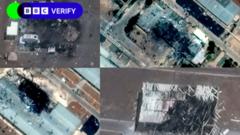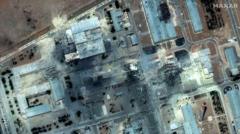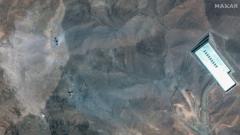### Summary: Satellite imagery analysis from multiple sources highlights severe damage to Iran's Natanz nuclear facility and missile sites, with indications of sophisticated weaponry used. Despite extensive destruction, no increase in radiation levels has been reported, prompting ongoing international scrutiny.
### Title: Satellite Images Unveil Extensive Damage to Iran's Nuclear and Military Sites

### Title: Satellite Images Unveil Extensive Damage to Iran's Nuclear and Military Sites
### Description: Recent satellite imagery reveals significant destruction at key Iranian nuclear facilities and military installations following recent strikes.
Recent satellite imagery has shed light on the substantial damage inflicted on Iran's pivotal nuclear sites and military installations as a result of airstrikes conducted recently. Images from different providers showcase the impact on the Natanz nuclear facility and a missile base in the vicinity of Tabriz, which were among the first targets hit during the military strikes aimed at Iran.
The satellite images, analyzed by organizations like the Institute for Space and International Security (ISIS) and Maxar Technologies, reveal the extent of the destruction at Natanz, particularly affecting the pilot fuel enrichment plant and an associated electrical substation. Rafael Grossi, the head of the International Atomic Energy Agency (IAEA), reported to the UN Security Council that the surface section of the plant, responsible for producing uranium enriched to 60% U-235, has been obliterated, underscoring the criticality of the situation. Enriched uranium is vital for both civilian nuclear energy and nuclear weapons development.
In a display of precision, footage verified shortly after the attacks captured clouds of smoke billowing from the targeted locations. Military analyst Justin Bronk suggested the nature of the explosions indicates the use of penetrating bombs like the GBU-31 or the more specialized GBU-28, historically employed by Israel to penetrate underground structures.
While Grossi noted damage to several key facilities in Isfahan, including the uranium conversion and fuel plate fabrication plants, he confirmed that there is currently no evidence of radiation leaking from either Natanz or Isfahan. This assessment has been echoed by the IAEA.
Other sites have also not shown indications of damage, including the Arak heavy water reactor and the Fordow enrichment facility, with Iranian media earlier claiming these locations had been targeted, a claim that has since been refuted by the Israeli Defense Forces.
Imagery captured by Umbra Space additionally details the destruction of multiple structures within a missile complex near Tabriz, including storage and launch facilities. In Kermanshah, extensive burn marks and structural damage were noted at a known missile base.
These developments mark a significant escalation in hostilities in the region, raising concerns about further military actions and their implications for global security.





















